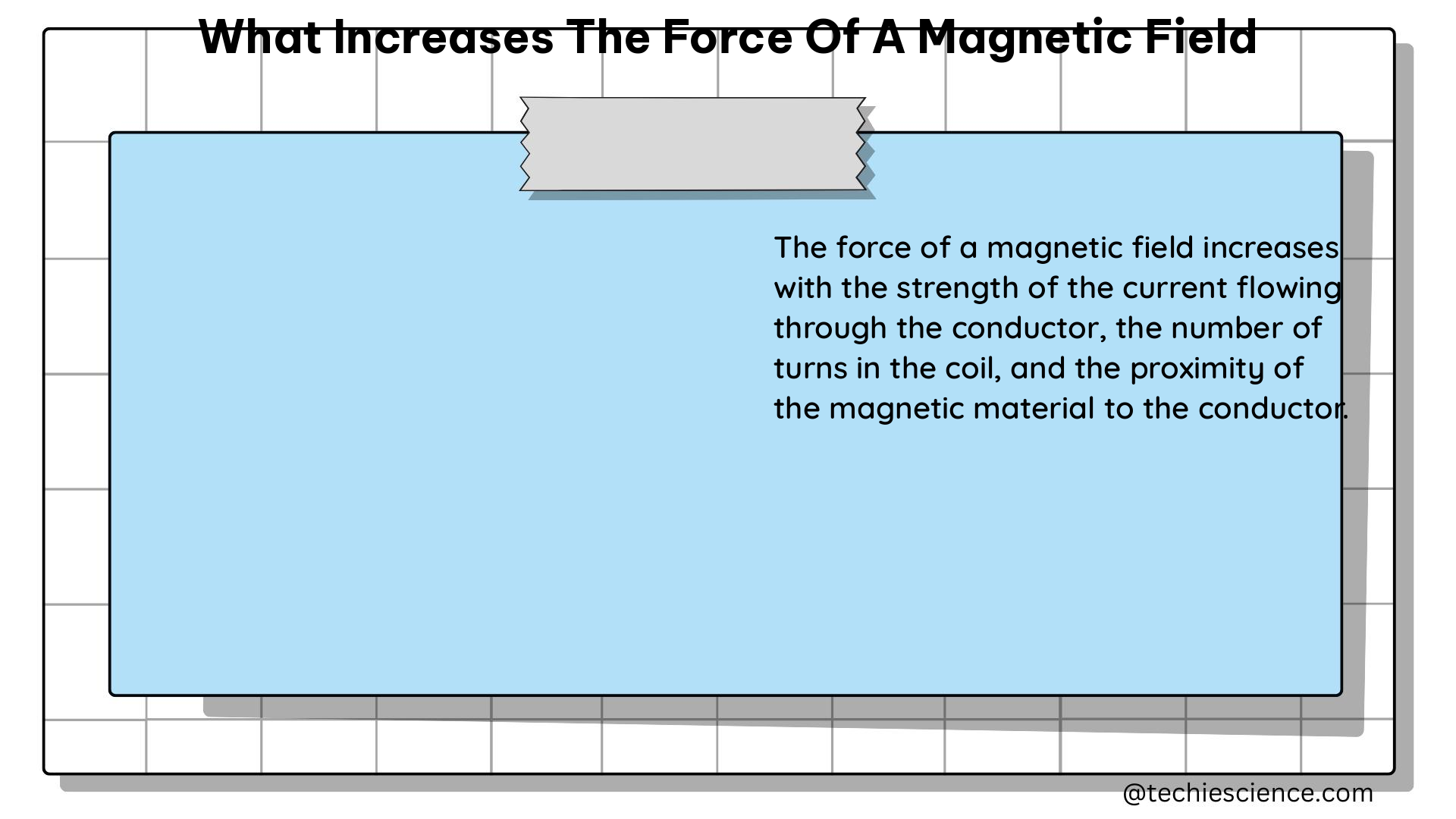The strength of a magnetic field is a crucial factor in various applications, from medical imaging to industrial processes. Understanding the factors that influence the force of a magnetic field is essential for optimizing these applications. In this comprehensive guide, we will delve into the technical details of what increases the force of a magnetic field, providing a valuable resource for physics students and enthusiasts.
Current Strength
The strength of a magnetic field is directly proportional to the current flowing through a wire, as described by Ampère’s law. The relationship between the magnetic field strength (H) and the current (I) is given by the formula:
H = (N × I) / l
Where:
– H is the magnetic field strength (in A/m)
– N is the number of turns in the coil
– I is the current flowing through the coil (in A)
– l is the length of the coil (in m)
This formula demonstrates that increasing the current flowing through a coil will result in a proportional increase in the magnetic field strength. For example, if the current is doubled, the magnetic field strength will also double, assuming all other factors remain constant.
Number of Turns

The magnetic field strength can also be increased by increasing the number of turns in a coil. This is because the magnetic field produced by each turn adds up to create a stronger overall field. The relationship between the number of turns (N) and the magnetic field strength (H) is given by the same formula:
H = (N × I) / l
As the number of turns (N) increases, the magnetic field strength (H) will also increase, provided that the current (I) and the length of the coil (l) remain constant.
Distance from the Source
The magnetic field strength decreases as the distance from the source increases, following an inverse square relationship. This is described by the formula:
B = (μ₀ × I × N) / (2 × π × r)
Where:
– B is the magnetic flux density (in T)
– μ₀ is the permeability of free space (4π × 10⁻⁷ H/m)
– I is the current flowing through the coil (in A)
– N is the number of turns in the coil
– r is the distance from the source (in m)
As the distance (r) increases, the magnetic flux density (B) decreases proportionally. Therefore, to increase the force of a magnetic field, it is essential to minimize the distance between the source and the target.
Magnetic Materials
The presence of magnetic materials in the vicinity of a magnetic field can significantly influence its strength. Magnetic materials can either concentrate or divert the magnetic field lines, thereby increasing or decreasing the field strength.
Ferromagnetic materials, such as iron, nickel, and cobalt, have a high magnetic permeability, which means they can easily be magnetized. When placed in a magnetic field, these materials can concentrate the field lines, resulting in an increase in the magnetic field strength. This phenomenon is known as magnetic flux concentration.
On the other hand, diamagnetic materials, such as copper and gold, have a low magnetic permeability and tend to divert the magnetic field lines. This can lead to a decrease in the magnetic field strength in the vicinity of these materials.
The effect of magnetic materials on the magnetic field strength can be quantified using the relative permeability (μr) of the material. The relative permeability is a dimensionless quantity that represents the ratio of the material’s permeability to the permeability of free space (μ₀). The higher the relative permeability, the more the material can concentrate the magnetic field lines, and the stronger the resulting magnetic field.
Magnetic Field Measurement
The strength of a magnetic field can be measured using various instruments, such as a gaussmeter or a magnetometer. The gaussmeter measures the magnetic flux density (B), which is the number of magnetic field lines passing through a given area. The unit of magnetic flux density is the tesla (T).
The magnetometer, on the other hand, measures the magnetic field strength (H), which is the force exerted on a moving charge in the magnetic field. The unit of magnetic field strength is the ampere per meter (A/m).
The relationship between the magnetic flux density (B) and the magnetic field strength (H) is given by the formula:
B = μ₀ × μr × H
Where:
– B is the magnetic flux density (in T)
– μ₀ is the permeability of free space (4π × 10⁻⁷ H/m)
– μr is the relative permeability of the material (dimensionless)
– H is the magnetic field strength (in A/m)
By measuring the magnetic flux density (B) and the magnetic field strength (H), it is possible to determine the relative permeability (μr) of the material, which can provide valuable information about the magnetic properties of the material and its ability to concentrate or divert the magnetic field lines.
Applications of Magnetic Field Strength
The measurement and control of magnetic field strength are crucial in various applications, including:
-
Magnetic Resonance Imaging (MRI): In MRI, the strength and homogeneity of the magnetic field are critical for image quality and patient safety. The magnetic field strength in MRI systems typically ranges from 0.5 to 7 Tesla.
-
Electric Motors and Generators: The strength of the magnetic field in electric motors and generators directly affects their efficiency and power output. Increasing the magnetic field strength can lead to higher torque and power generation.
-
Particle Accelerators: In particle accelerators, such as cyclotrons and synchrotrons, strong magnetic fields are used to guide and control the motion of charged particles. The magnetic field strength in these devices can reach several Tesla.
-
Magnetic Levitation: Magnetic levitation, or maglev, technology relies on the precise control of magnetic field strength to suspend vehicles or objects above a track or surface without physical contact.
-
Magnetic Separation: Magnetic separation is used in various industries, such as mining and recycling, to separate magnetic materials from non-magnetic materials. The strength of the magnetic field is a critical factor in the efficiency of this process.
By understanding the factors that influence the force of a magnetic field, researchers, engineers, and technicians can optimize the design and performance of these and other applications that rely on the manipulation and measurement of magnetic fields.
Conclusion
In this comprehensive guide, we have explored the various factors that influence the force of a magnetic field, including current strength, number of turns, distance from the source, and the presence of magnetic materials. We have also discussed the measurement of magnetic field strength using gaussmeters and magnetometers, as well as the importance of magnetic field strength in various applications.
By understanding these technical details, physics students and enthusiasts can gain a deeper appreciation for the principles governing magnetic fields and their practical applications. This knowledge can be invaluable in fields such as engineering, medical imaging, and particle physics, where the precise control and measurement of magnetic fields are crucial.
References
- Stan Zurek, “Magnetic field,” Encyclopedia Magnetica, https://www.e-magnetica.pl/doku.php/magnetic_field
- TeachEngineering, “Magnetic Fields and Distance – Activity,” https://www.teachengineering.org/activities/view/rice_magnetic_activity1
- MR quiz questions – Magnets and Scanners, https://mriquestions.com/nmr-phenomenon-quiz.html
- Quizlet, “Forces, Motion, and Newton’s Laws Test Study Guide,” https://quizlet.com/475571539/forces-motion-and-newtons-laws-test-study-guide-flash-cards/
- ScienceDirect Topics, “Measurable Quantity – an overview,” https://www.sciencedirect.com/topics/engineering/measurable-quantity

Hi,
I am Megha B R, I have completed my Post-Graduation in Solid State Physics and pursuing B. Ed. I am a Physics enthusiast. As an Academic writer, my goal is to reach the readers in a simplified manner through my articles.
Let’s connect through LinkedIn-